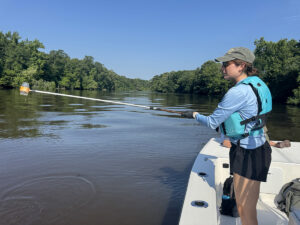News
Riverkeeper introduced to aerial investigation
CAFOs, Climate Change, Environmental, Flooding, Neuse River Watershed, Sound Rivers, Tar-Pamlico Watershed, Water Quality
Posted on October 26th, 2023
An aerial view of the Moye Farms facility that flooded during hurricanes Floyd and Matthew.
Pamlico-Tar Riverkeeper Katey Zimmerman got her first aerial view of threats to eastern North Carolina waterways this week.
“It was a really clear, good day for flying, so there wasn’t much turbulence — it was really cool,” Katey said.
She joined Neuse Riverkeeper Samantha Krop for the flight out of New Bern on Wednesday. From there, they headed to the Kinston area, and six points of interest.
“We flew over a couple poultry facilities as part of our ongoing investigation into elevated E. coli levels in the Neuse River in Kinston — the Sanderson Farms Facility and another poultry facility right along the Neuse River, just across from Sanderson Farms,” Sam said.
Midway through the regular Swim Guide season, testing of water samples at the Highway 11 boat ramp in Kinston returned extremely elevated levels of bacteria, prompting an investigation into the source.
“The DNA sample that we did in this area came up with high with poultry DNA, so our next move will be to paddle the area to collect samples along the way and try to pinpoint one of these sources,” Sam said.

Sound Rivers is also reaching out to the North Carolina Department of Environmental Quality about the second poultry facility, which had mounds of chicken litter piled up near the banks of the Neuse River.
Another destination was a concentrated animal feeding operation in Greene County with a long history of failing to maintain its waste management system. The industrial swine facility also flooded during hurricanes Floyd and Matthew.
“The abandoned Moye Farms hog lagoon is located in the floodplain, right alongside Contentnea Creek. That lagoon looks to be partially drained, such that I wonder if this is in the process of being decommissioned,” Sam said.
“The facility has failed in the past and is a prime example of why we need buyout funds to get these waste lagoons out of the floodplain.”
For Katey, the aerial experience was appreciated.
“I’d never been up in small plane like that and the whole idea of doing pollution investigations from the sky — it was good to see how that process works,” Katey said. “In general, for pollution investigations, it’s really helpful to have these resources to be able to fly over the sites and see what’s actually going on. A lot of the time, you aren’t actually able to access these places.”
Sam and Katey flew with a pilot from D2 Flight Academy.
Related News

Specialist investigates lake connection to mysterious skin rash
July 10th 2025

Riverkeeper: Central NC flooding part of a much larger issue
July 10th 2025

N.C. Governor vetoes bad rulemaking bill
July 10th 2025

Riverkeeper, program director ‘Growing More than Rain Gardens’
July 10th 2025

Volunteer coordinator goes ‘fishing’
July 10th 2025

Neuse fish kill expected to extend beyond holiday weekend
July 3rd 2025

Swim Guide fails prompt Maple Cypress investigation
July 3rd 2025

Riverkeeper, town partners root out source of Smithfield sediment pollution
July 3rd 2025

